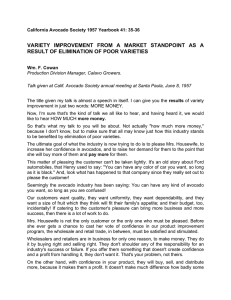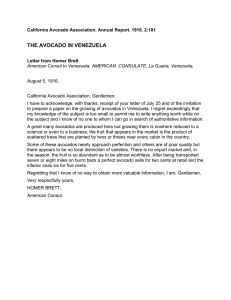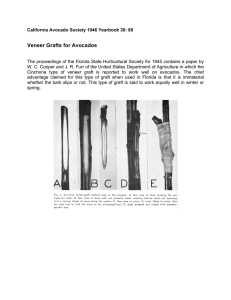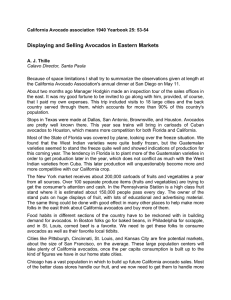REPORT OF THE VARIETY COMMITTEE
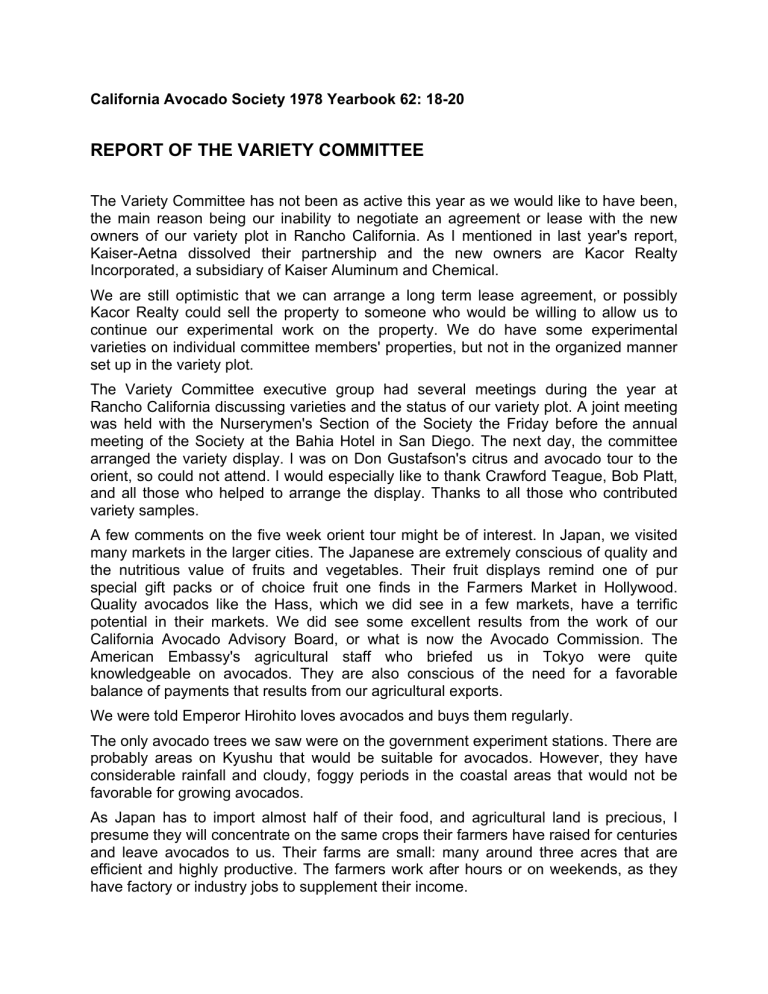
California Avocado Society 1978 Yearbook 62: 18-20
REPORT OF THE VARIETY COMMITTEE
The Variety Committee has not been as active this year as we would like to have been, the main reason being our inability to negotiate an agreement or lease with the new owners of our variety plot in Rancho California. As I mentioned in last year's report,
Kaiser-Aetna dissolved their partnership and the new owners are Kacor Realty
Incorporated, a subsidiary of Kaiser Aluminum and Chemical.
We are still optimistic that we can arrange a long term lease agreement, or possibly
Kacor Realty could sell the property to someone who would be willing to allow us to continue our experimental work on the property. We do have some experimental varieties on individual committee members' properties, but not in the organized manner set up in the variety plot.
The Variety Committee executive group had several meetings during the year at
Rancho California discussing varieties and the status of our variety plot. A joint meeting was held with the Nurserymen's Section of the Society the Friday before the annual meeting of the Society at the Bahia Hotel in San Diego. The next day, the committee arranged the variety display. I was on Don Gustafson's citrus and avocado tour to the orient, so could not attend. I would especially like to thank Crawford Teague, Bob Platt, and all those who helped to arrange the display. Thanks to all those who contributed variety samples.
A few comments on the five week orient tour might be of interest. In Japan, we visited many markets in the larger cities. The Japanese are extremely conscious of quality and the nutritious value of fruits and vegetables. Their fruit displays remind one of pur special gift packs or of choice fruit one finds in the Farmers Market in Hollywood.
Quality avocados like the Hass, which we did see in a few markets, have a terrific potential in their markets. We did see some excellent results from the work of our
California Avocado Advisory Board, or what is now the Avocado Commission. The
American Embassy's agricultural staff who briefed us in Tokyo were quite knowledgeable on avocados. They are also conscious of the need for a favorable balance of payments that results from our agricultural exports.
We were told Emperor Hirohito loves avocados and buys them regularly.
The only avocado trees we saw were on the government experiment stations. There are probably areas on Kyushu that would be suitable for avocados. However, they have considerable rainfall and cloudy, foggy periods in the coastal areas that would not be favorable for growing avocados.
As Japan has to import almost half of their food, and agricultural land is precious, I presume they will concentrate on the same crops their farmers have raised for centuries and leave avocados to us. Their farms are small: many around three acres that are efficient and highly productive. The farmers work after hours or on weekends, as they have factory or industry jobs to supplement their income.
We enjoyed the beauty of Japan. Our hosts were always friendly and helpful. The country sides and cities are clean and tidy. They are faced with overcrowded cities and traffic problems. In spite of this, the people—and especially the children—seem happy.
One admires their patience and loyalty to the companies they work for.
Our next stop was Taiwan, a beautiful, more tropical island rich in agriculture. We spent a week here flying or traveling by bus with excellent guides and government agricultural advisors. Almost all tropical and semitropical fruits are grown here with the exception of avocados. They have a severe phytophthora problem and also seasonal typhoons that would be hazardous for avocados on a commercial scale. This country is just starting to forge ahead. They have a terrific potential in industry and agriculture. Taipei is a modern, progressive city and one of the crossroads of Southeast Asia. Tourism is becoming a major industry.
Our next stop was Hong Kong, with its crowded, spectacular city of skyscraper buildings and apartments. We enjoyed the markets and the excellent displays of fruits. This is a future excellent market for avocados that we have barely touched. Practically all their food is imported, and I'm sure avocados could be used more in the major hotels.
We had a special tour to the New Territories next to the China border. Here, we visited the Kadoorie Experimental and Extension Farm and Botanic Gardens. This was quite an experience: an unbelievable collection of plants and fruits, and even livestock and fish. All were beautifully landscaped and arranged. They had a nice mixed citrus planting, but no avocados. Talking with some of the staff, I was told of areas in southern
China where citrus is grown that would be excellent avocado areas. Much of the produce for Hong Kong comes from China delivered by boat, or from the border through the New Territories area.
On our way home, we spent a week in Hawaii touring the agricultural areas of Kauai,
Maui, Hawaii, and Oahu. There are very few avocados left in the islands; mostly odd trees here and there. They are mostly old, long-ago discarded California Guatemalan varieties. We saw two very nice new variety plots, on Kauai and at Hilo, under the
University of Hawaii farm extension.
A shortage of labor and the high price of land are discouraging to agricultural development. Most discouraging was a large corporation's papaya orchard on Maui that was going to be abandoned. A bright spot is the macadamia industry on the island of
Hawaii. They are reclaiming rocky lava formations and planting macadamias that just seem to thrive under these conditions. They have an excellent advertising and promotion program to increase sales of these exotic nuts.
Hawaii residents have little interest in avocados, as they have many kinds of fruit in their back yards and other areas, and would not pay the high prices of imported fruit.
However, all the people on our tour felt there is much that could be done to encourage more usage by hotels that service the tourist industry.
Those who went on the trip were: Mrs. Leonora Pierotti, Fullerton; Mrs. Helen DuPree,
Hacienda Heights; Ms. Barbara Ralston, Mr. and Mrs. Horace Whittaker, Goleta; Mr. and Mrs. Jim Bacon, Buena Park; Mr. and Mrs. Stan Nelson, Lilac; Mr. and Mrs. Don
Gustafson, Poway; Mr. and Mrs. Al Snider, Mr. and Mrs. Vern Watson, Mrs. Jeanette
Waterhouse, and Mr. and Mrs. Oliver Atkins, Fallbrook.
As I am concluding this report on the nights of December 6th, 7th, and 8th, we have just gone through what is apparently a serious freeze—especially so in some locations of our California avocado areas. This is not new to our older growers, but it is most discouraging to the many new growers who have planted acreage in the last few years and are in an area that has suffered damage. This report will make no attempt to cover this freeze. However, the Variety Committee is faced with the problem of recommending and developing newer cold resistant varieties for these marginal areas. The last thing the industry needs is an increase in Zutano, Bacon, and other fall varieties that mature just before and during the Christmas season. The housewife becomes dissatisfied with the quality and flavor of these fruits and becomes hesitant to make repeat purchases.
The Variety Committee has been cognizant of this for years. Hopefully, with Dr. Bergh's breeding program and the possibility of a chance seedling showing up, we should come up with a satisfactory fall variety in the near future.
I would especially like to thank our Variety Committee members for their help and cooperation in a year that has had problems that I'm sure we can solve in the near future.
Respectfully submitted,
Oliver H. Atkins
